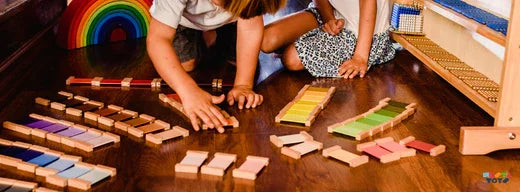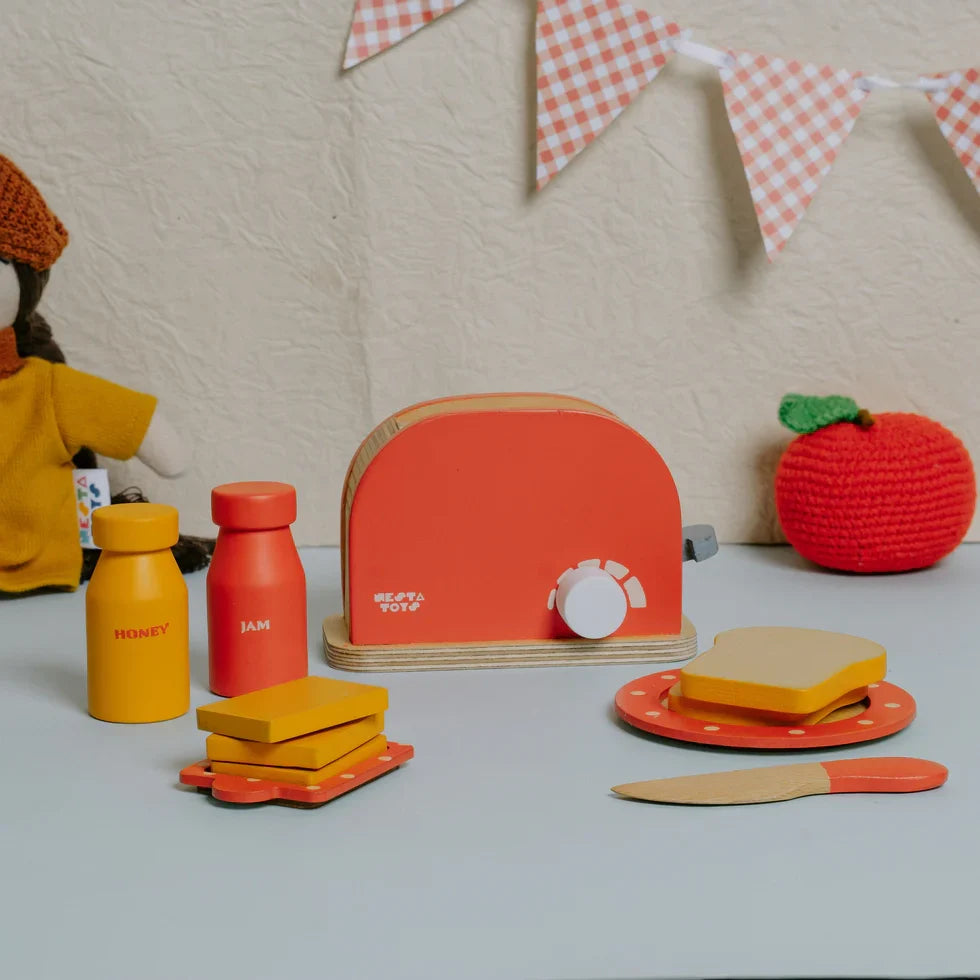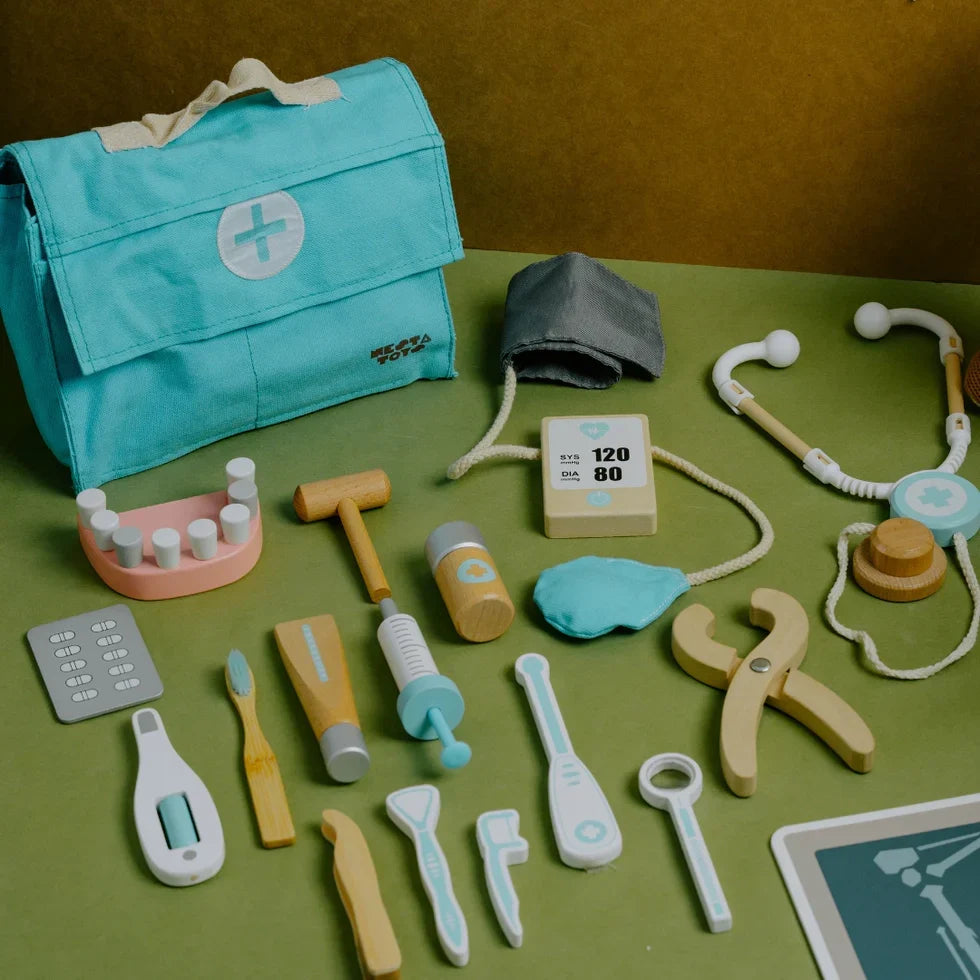The Montessori Thematic Tablets activity is designed to help children refine their thermic sense through hands-on exploration. In this activity, kids explore six pairs of tablets made from different materials like wood, felt, cork, marble, and iron, each with unique heat-conducting properties. By touching and comparing them, they can experience and understand temperature differences in a fun and hands-on way.
How to Set Up the Activity at Home?
Materials Needed:
- A box with six pairs of tablets, each made from different materials like wood, felt, cork, marble, and iron. Each pair is identical in shape and size but differs in material, allowing children to explore and compare their unique heat-conducting properties.
- A blindfold to help your child focus on touch, enhancing their ability to sense temperature differences without using their sight.
- A quiet, well-lit working space where your child can concentrate and engage with the materials without distractions.
Step 1: Introducing the Material
- Begin by sitting down with your child at a clean, quiet table where they can work comfortably.
- Open the box and lay out one tablet from each pair in a row on the table. Arrange them slightly to the left to keep them organized and easy to manage.
- Guide your child to use the sensitive part of their wrist to feel the tablet, as this area can detect subtle temperature differences. Show them by gently placing your wrist on the first tablet and explaining whether it feels warm, cool, or neutral.
- Encourage your child to explore the first tablet by placing their wrist on it, just as you demonstrated. You can also describe its texture—whether it feels smooth, rough, or soft—to further engage their senses and enhance their learning experience.
Step 2: Matching Activity
- After your child has explored the first tablet, mix up the remaining tablets and place them randomly in front of them. Now, they will need to rely on their sense of touch to find and match the pairs based on temperature and texture.
- Gently close your eyes (or use the blindfold) and explain that you will be using your sense of touch to find the tablet that matches the first one based on temperature and texture.
- Ask your child to do the same: close their eyes and feel the tablets one by one, moving from left to right along the row. Encourage them to pay close attention to the temperature of each tablet and compare it to the first one they felt.
- When they find a tablet that feels similar in temperature to the first one, encourage them to place it beside the first tablet. Ask them to confirm the match by feeling both tablets again to ensure they feel the same.
- Continue the activity until all the tablets have been matched. Remind your child to take their time, focus on the sensory experience, and enjoy discovering the differences rather than rushing through the process.
Step 3: Language Reinforcement
- As your child matches the tablets, use the opportunity to expand their vocabulary. Describe the temperature and texture of each tablet with words like "warm," "cold," "smooth," "rough," "soft," "cool," "neutral," and "hard," helping them develop a richer understanding of sensory experiences.
- Ask questions like, "How does this tablet feel?" or "Can you describe how it is different from the other one?" to encourage your child to think critically and express their sensory experience in their own words.
- Reinforce your child's responses by validating their observations and mirroring their descriptions. For example, if they say a tablet feels warm, you can respond with, "Yes, this tablet feels warm and smooth, just like the one before." This helps build their confidence and strengthens their sensory awareness.
Step 4: End the Activity
-
- After matching all the tablets, guide your child in wrapping up the activity by placing each matched pair back into its designated slot in the box.
- Make sure the tablets are placed back carefully in their correct order. This reinforces organization skills and encourages your child to take responsibility for the materials.
- Encourage your child to take pride in the completed task by acknowledging their effort and involvement in the process.
By having your child match the tablets based on temperature and texture, you’re not only sharpening their sensory skills but also helping them develop language and critical thinking abilities. This activity also enhances your child’s concentration, attention to detail, and ability to follow instructions, all of which are key components of the Montessori philosophy.

Suggested Activities to Enhance Learning: You can enhance the learning experience by engaging your child in activities that explore temperature differences. Here are a few ideas to deepen their understanding:
- Temperature Sorting: Collect a variety of objects with different temperatures, such as ice cubes, warm water, a hot cup, and room-temperature items. Encourage your child to touch each one and sort them from cold to warm, helping them better understand temperature differences through hands-on exploration.
- Hot and Cold Sensory Bins: Set up two sensory bins—one filled with warm water and the other with ice or chilled water. Let your child explore different objects in each bin, and talk about how the temperatures feel, encouraging them to describe their sensations as they play.
- Sensory Thermometers: Fill clear containers with warm and cold water, adding food coloring to distinguish them (e.g., red for warm, blue for cold). Encourage your child to place objects in each container and sort them based on how they feel in different temperatures.
- Hot and Cold Beverage Tasting: Make both hot and cold beverages, like hot chocolate and iced tea. Let your child taste each one and discuss how the temperature affects the way it feels and tastes, helping them connect sensory experiences with real-life situations.
- Cooking Experiments: Engage your child in simple cooking activities like melting chocolate, making ice cream, or boiling water. Talk about how the temperature changes throughout the process, encouraging them to touch and feel the transformations.
- Outdoor Temperature Exploration: Take your child outside at different times of the day to experience how the temperature changes from morning to afternoon to evening. Encourage them to touch various surfaces like soil, metal, and leaves to feel the differences and discuss how temperature varies throughout the day.
These activities help children develop their sensory awareness, refine their thermic sense, and learn about the world around them in an engaging and playful way. By incorporating these activities into your homeschooling routine, you're providing your child with the opportunity to develop key skills through meaningful sensory experiences.








